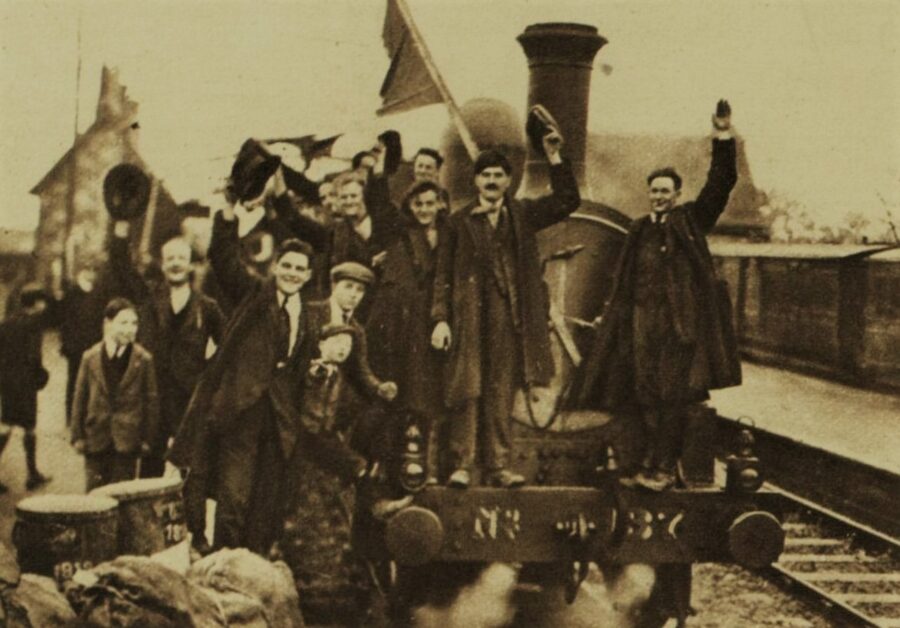
Kieran’s Our City, Our Town Article,
Cork Independent, 16 December 2021
Journeys to a Truce: The Release of the Internees
Within forty-eight hours after the details of the Articles of Agreement were signed on 6 December 1921, the British government approved the release of all people who had been imprisoned under the Restoration of Order (Ireland) Act, known to many as the Coercion Act. The order did not extend to prisoners who had been either convicted or who were under trial. Between 3,000 and 4,000 prisoners were released from Ballykinlar Camp in County Down, the Rath Camp in the Curragh, Portlaoise Jail as well as from Waterford, Cork, Kilmainham, Mountjoy and other prisons respectively. Special train services have been arranged to transport the liberated men and women home.
At Ballykinlar, County Down, on Thursday 8 December the southern internees were up at 6am and marched from the camp to the nearest station, TullyBridge, where they connected with the Great Northern Railway. Three special trains brought the men to Dublin, from where the internees made their own way to their home counties. Their luggage was taken in military lorries. The previous night the men were allowed to wander about the camp freely.
The Cork Examiner describes that on one train Sinn Féin flags were displayed, and at Newcastle a large crowd welcomed the ex-prisoners and supplied them with tea, cigarettes and fruit. The train proceeded with its journey. At Katesbridge near Banbridge, County Down, stones and nut bearings were flung at the train by Loyalists and shots were also discharged. Two of the prisoners were slightly wounded. The last carriage had hardly passed out of Katesbridge station when a shower of stones from an unseen quarter rattled upon it. Several cars were struck, and windows broken.
In the next few hundred yards shots were fired from the left on side of the track, apparently from behind the hedge, and then shortly, two from the right came. One bullet passed through the window of a parked compartment, smashing the glass and sending splinters of the window pane over the prisoners. One was severely lacerated by the glass and the second had a very narrow escape. He was sitting by the window and a bullet passed right in front of his face and right out of the open window of the carriage door. In another compartment a John Fitzgerald of Kilbritain County Cork was struck in the head by flying glass. First aid was rendered by his companions. At Banbridge the train was again attacked after passing the station stones rattled off the carriage sides broke some windows.
The train eventually arrived at Dublin’s Amiens Street station (now Connolly Station) and crowds of people awaited the newly released interns. A mass of general public lined the platform on the station precincts and all along Talbot Street to the O’Connell Monument.
A Cork Examiner reporter spoke to a few of the released southern internees. They noted that they had no chance of reading yet the nature of the difference of opinion between the leaders as regards the Treaty terms and would not express any opinion on the matter.
The train bound for Cork City commenced its journey at 10am on Friday morning. It contained about 400 men, but of those, only about 100 came to Cork – the others having left the various stations on the way home. All along the route, the people crowded the station platforms patiently awaiting the train and the ex-internees were given a rousing welcome.
Long before the train is due in Cork City, the platform, the station precincts, and approaches were packed. Hundreds stood on the nearby bridge over the railway and many others occupied positions on the steps leading up to St Luke’s, and money were waiting along the Lower Road and MacCurtain Street.
The excited crowds on the platform gave even the passing of single engines and the lines of people increased with tears, surged to and fro, laughing and shouting, and the best of good humour. Many climbed on seats and railings to get a better view.
When the bell denoted the train approached the excitement became intense. The advent of the train a few minutes later at 2.30pm was greeted with thunderous cheers with fog signals released adding to the uproarious demonstration.
Three tricolours were fixed to the front of the engine and from every window flags were waved for the homecoming man. On each of the carriages such inscriptions and chalk, as “Up Spike”, “Sinn Féin abú”, were written, amongst other messages.
The eagerness to which the crowds rushed to the carriage doors made it impossible for the prisoners to step onto the platform, until a path had been cleared for them. Then the eagerness was replaced by conversations, laughter, congratulations, and personal welcomes. The crowd slowly left the platform. The released men left the station grounds on vehicles of all descriptions, and drove off with the relatives to the different parts of the city. Hundreds lined both sides of the road for some distance from the station entrance with the public cheering, waving hats and handkerchiefs with the ex-internees joyfully responding.
Four special carriages were dispatched out from Cork on Friday morning, 9 December on the West Cork Rail line to support the released internees from Bere Island. On Bere Island two hundred prisoners were loaded onto to War Office steamers to Bantry where the special train conveyed them to Cork. The whole Bere Island and the adjacent mainland was ablaze with bonfires on the release.
Caption:
1130a. Released prisoners from Maryborough Internment Camp, Portlaoise, celebrating while standing on an engine (source: Illustrated London News, 17 December 1921).